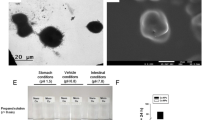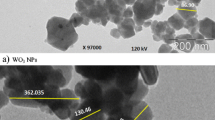Abstract
Copper oxide (II) nanoparticles (CuO-NPs) have been increasingly used in products of human interest, such as coating for food packaging and wood protection. The main objective of this study was to evaluate in vivo acute toxicity of CuO-NPs after oral exposure and compare it with CuO microparticles (CuO-MPs). Female rats were orally exposed, through gavage procedure, to the analyzed materials. After 14 days of observation, hematological, biochemical, histopathological, and copper organ accumulation analyses were performed. CuO-NPs (25.17 ± 8 nm) and CuO-MPs (1.092 ± 0.52 μm) were characterized and compared regarding their acute oral toxicity. Animals treated with CuO-NPs at the dose of 2000 mg kg−1 presented changes in feces and copper hepatic accumulation. Histopathological exam of livers demonstrated hepatocyte binucleation and megalocytosis. None of the animals tested with CuO-MPs showed any alterations. Oral exposure to CuO-NPs, at the dosage of 2000 mg kg−1, may cause mild transitory liver damage, mainly resolved during a 14-day post-exposure period. Also, the nanoparticulated material showed to be more toxic than the microparticulated one.

CuO nanoparticles (25.17 ± 8 nm) and microparticles (1.092 ± 0.52 μm) had their oral acute toxicity evaluated and compared using female Wistar rats. After 14 days of observation, hematological, biochemical, histopathological, and copper organ accumulation analyses were performed. At the higher nanoparticle dose, changes in feces, histopathological signs and copper hepatic accumulation were demonstrated. No toxic signs were found at any microparticle dose.





Similar content being viewed by others
References
Ahamed MAH, Alhadlaq HA, Khan MM, Karuppiah P, Al-Dhabi NA (2014) Synthesis, characterization, and antimicrobial activity of copper oxide nanoparticles. J Nanomater 2014:1–4
Ahamed M, Akhtar MJ, Alhadlaq HA, Alrokayan SA (2015) Assessment of the lung toxicity of copper oxide nanoparticles: current status. Nanomedicine (London) 10:2365–2377
Armstrong CW, Moore LW Jr, Hackler RL, Miller GB Jr, Stroube RB (1983) An outbreak of metal fume fever. Diagnostic use of urinary copper and zinc determinations. J Occup Environ Med 25:886–888
Ben-Moshe T, Dror I, Berkowitz B (2009) Oxidation of organic pollutants in aqueous solutions by nanosized copper oxide catalysts. Appl Catal B Environ 85:207–211
Bhaumik A et al (2014) Copper oxide based nanostructures for improved solar cell efficiency. Thin Solid Films 572:126–133
Bugata LSP et al. 2019. Acute and subacute oral toxicity of copper oxide nanoparticles in female albino Wistar rats. J Toxicol.;1 – 15
Cheifetz AS et al (2011) Oxford American handbook of gastroenterology and hepatology. Oxford University Press, Oxford
Chen Z et al (2006) Acute toxicological effects of copper nanoparticles in vivo. Toxicol Lett 163(2):109–120
Conselho Federal de Medicina Veterinária (CFMV) 2013 Guia Brasileiro de Boas Práticas em Eutanásia em Animais / Brazilian guide of good practices for animal euthanasia. – Brasília
Evans P, Matsunaga H, Kiguchi M (2008) Large-scale application of nanotechnology for wood protection. Nat Nanotechnol 3:577
Fröhlich E, Salar-Behzadi S (2014) Toxicological assessment of inhaled nanoparticles: role of in vivo, ex vivo, in vitro, and in silico studies. Int J Mol Sci 15(3):4795–4822
Gosens I et al (2016) Organ burden and pulmonary toxicity of nanosized copper (II) oxide particles after short-term inhalation exposure, Nanotoxicology. Nanotoxicology 10(8):1084–1095
Instituto Nacional de Metrologia, Qualidade e Tecnologia – Inmetro (2016) Orientação sobre validação de métodos analíticos. Inmetro, Rio de Janeiro
Karlsson H et al (2009) Size-dependent toxicity of metal oxide particles—a comparison between nano- and micrometer size. Toxicol Lett 188(2):112–118
Kim JS, Adamcakova-Dodd A, O’shaughnessy PT, Grassian VH, Thorne PS (2011) Effects of copper nanoparticle exposure on host defense in a murine pulmonary infection model. Part Fibre Toxicol 8:29
Linder MC (2001) Copper and genomic stability in mammals. Mutat Res 475:141–152
Longano D, Ditaranto N, Cioffi N, DiNiso F, Sibillano T, Ancona A et al (2012) Analytical characterization of laser-generated copper nanoparticles for antibacterial composite food packaging. Anal Bioanal Chem 403:1179–1186
lPCS (International Program On Chemical Safety) 1998 Environmental health criteria 200: copper. Geneva, Switzerland: World Health Organization, p. 360
Mancuso L, Cao G (2014) Acute toxicity test of CuO nanoparticles using human mesenchymal stem cells. Toxicol Mech Methods 24(7):449–454
McGavin MD, Zachary JF (2009) Pathologic basis of veterinay disease, 4th edn. Elsevier, Amsterdam
Organisation for Economic Co-Operation and Development (OECD). 2001. Guideline for testing of chemicals: acute oral toxicity – fixed dose procedure: guide 420. Paris
Organisation for Economic Co-Operation and Development (OECD). 2009. Preliminary review of OECD test guidelines for their applicability to manufactured nanomaterials. Paris
Otto DP, de Villiers MM (2013) Why is the nanoscale special (or not)? Fundamental properties and how it relates to the design of nano-enabled drug delivery systems. Nanotechnol Rev 2:171–199
Otto DP, Otto A, de Villiers M (2014) Differences in physicochemical properties to consider in the design, evaluation and choice between microparticles and nanoparticles for drug delivery. Expert Opin Drug Deliv 12(6)
Peoples SM, Mccarthy JF, Chen LC, Eppelsheimer D, Amdur MO (1988) Copper oxide aerosol: generation and characterization. Am Ind Hyg Assoc J 49:271–276
Pettibone JM, Adamcakova-Dodd A, Thorne PS, O’shaughnessy PT, Weydert JA, Grassian VA (2008) Inflammatory response of mice following inhalation exposure to iron and copper nanoparticles. Nanotoxicology 2:189–204
Piret JP et al (2012) Copper (ii) oxide nanoparticles penetrate into HepG2 cells, exert cytotoxicity via oxidative stress and induce pro-inflammatory response. Nanoscale 4(22):7168–7184
Privalova L et al (2014) Subchronic toxicity of copper oxide nanoparticles and its attenuation with the help of a combination of bioprotectors. Int J Mol Sci 15(7):12379–12406
Ren G, Hu D, Cheng EW, Vargas-Reus MA, Reip P, Allaker RP (2009) Characterisation of copper oxide nanoparticles for antimicrobial applications. Int J Antimicrob Agents 33:587–590
Yokohira M et al (2008) Lung toxicity of 16 fine particles on intratracheal instillation in a bioassay model using F344 male rats. Toxicol Pathol 36(4):620–631
Zenou M, Ermak O, Saar A, Kotler Z (2014) Laser sintering of copper nanoparticles. J Phys D Appl Phys 47:025501
Acknowledgments
The authors would like to thank the whole team from Laboratório de Farmacologia and workers from Serviço de Animais de Laboratório (DFT/INCQS) for their help with animals’ care and procedures. A special thanks to Dr. José Mauro Granjeiro and Dr. Luciene Bottentuit Lopez Balottin for donating the CuO nanoparticles and the Clinical Analysis Platform from ICTB for hematological and biochemical exams. Thanks also to MSc. Janine Boniatti and Lucas Gonçalves Imbruglia Regis from the Laboratório de Estudos do Estado Sólido, Farmanguinhos, for helping with SEM analysis. We also want to thank all the animals that gave their lives for the improvement of scientific knowledge.
Author information
Authors and Affiliations
Corresponding authors
Ethics declarations
This study was performed at Serviço de Animais de Laboratório, INCQS, Fiocruz, and it was approved by Fiocruz’s Animal Experimentation Ethical Committee under license number LW-37/17.
Conflict of interest
The authors declare that they have no conflict of interest.
Disclaimer
The authors alone are responsible for the content and writing of the paper.
Additional information
Publisher’s note
Springer Nature remains neutral with regard to jurisdictional claims in published maps and institutional affiliations.
Rights and permissions
About this article
Cite this article
Maciel-Magalhães, M., Medeiros, R.J., Bravin, J.S. et al. Evaluation of acute toxicity and copper accumulation in organs of Wistar rats, 14 days after oral exposure to copper oxide (II) nano- and microparticles. J Nanopart Res 22, 2 (2020). https://doi.org/10.1007/s11051-019-4721-0
Received:
Accepted:
Published:
DOI: https://doi.org/10.1007/s11051-019-4721-0




